Your kids will be amazed by this simple burning candle rising water science experiment. This rising water experiment will teach your kids the effect of air pressure.
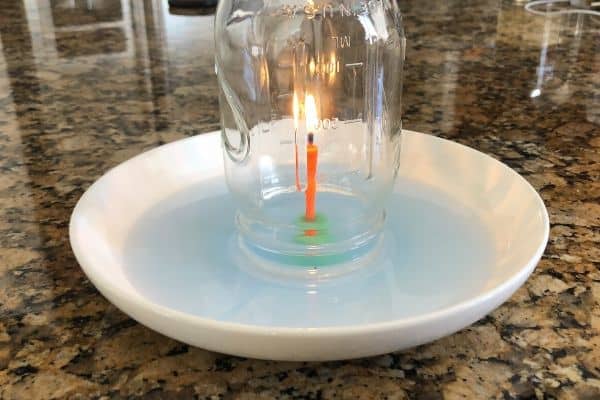
This burning candle in water is one of those science experiments that appear like magic.
With just a few items and a few steps, you can demonstrate to your how to rise the water inside the cup or jar without ever touching it.
Get your camera ready, your kid is going to have his mind blown by this amazing “why does the water rise” science experiment!
Burning Candle Rising Water Science Experiment
Materials:
- A plate with a raised rim or a shallow bowl
- Water
- Candle
- Lighter or matches
- Drinking glass or mason jar
- Optional: food coloring
- Optional: Playdough
- Free rising water experiment worksheet (download directions at the bottom of the post)
Instructions:
1. Place the candle in the middle of the plate or bowl.
2. Optional: If your candle can’t stand by itself, use some playdough to help it stand upright.
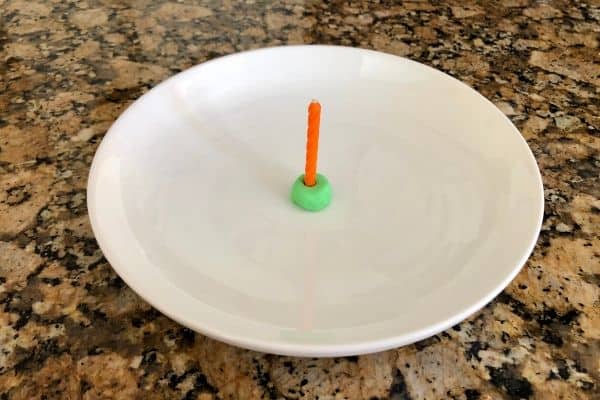
3. Optional: Mix water with food coloring in a separate container. The food coloring helps you see the rising water better.
4. Pour the colored water into the plate (to about 1 cm in depth).
5. Light the candle with a lighter or match.
If you are using the free rising water experiment worksheet, you can ask your child to draw his prediction of what will happen when you place the glass over the candle on the paper.
6. Turn the glass or mason jar upside down and place it over the candle.
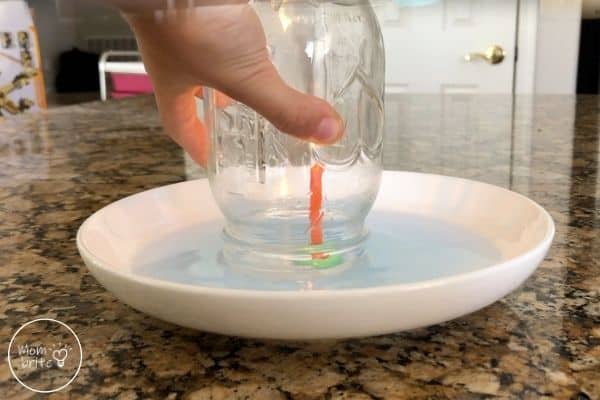
7. Watch what happens to the water when the fire is still burning, and what happens when the fire extinguishes.
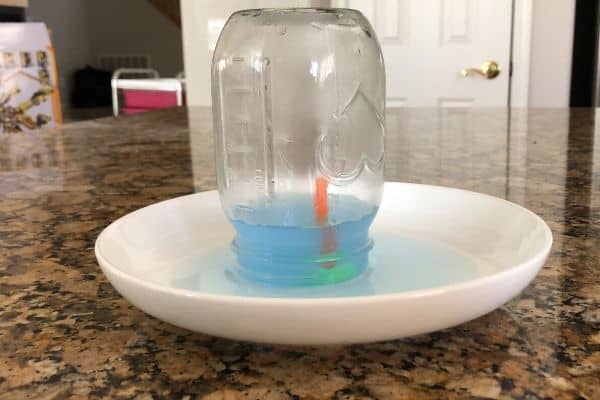
Did your kid’s jaw drop when the water rises when the candle went out?
Mine loved watching the sudden rise in water level inside the glass so much that we did the experiment over and over again until the candle couldn’t light anymore.
Don’t forget to have your child write or draw his observation in the rising water worksheet! Then read on to find out why the water started flowing into the jar after the candle was extinguished.
The Science Behind the Rising Water Experiment
Have your kids make an educated guess (hypothesis!) on why did the water rise when the candle went out, and why did the candle go out in the first place.
The candle went out without us blowing on it because it ran out of oxygen. The flame used up oxygen as it burned, and since the candle was trapped inside a glass, it quickly used up the available oxygen. Without oxygen inside the glass, the candle could not keep burning.
When the candle was still burning, the flame heated up the air inside the glass. The hot air expanded quickly and created higher air pressure inside the glass than outside the glass.
To restore equilibrium, some of the high-pressure air inside escaped from under the glass. You may have seen tiny bubbles escaping from underneath the glass.
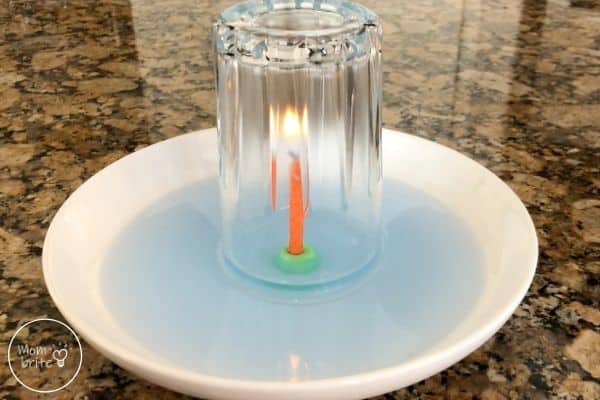
When the flame extinguished, the air inside the glass cooled down. Cooling air contracted, which in turn lowered the air pressure inside the glass.
Just as before when air rushed out from the glass to balance the air pressure between the inside and outside of the glass, now air wants to get in. As a result, the high-pressure air outside the glass pushes on the water, forcing the water into the glass.
Visually, we can see the water level rising until the air pressure inside the glass is the same as the air pressure outside the glass.
Science Extensions to Try
What variables can you test to see how they impact the water rising?
- Use hot water or cold water instead of room temperature water. Does the temperature of the water matter?
- Use a larger candle or smaller candle. Does the size of the candle matter?
- Use multiple candles. Does the increase in candles (and hence, larger flames) change the water level?
- Use a different liquid like vinegar or milk instead of water. Does the type of liquid change the outcome?
- Pour more or less water in the plate. Does the amount of water affect how much water gets pushed into the glass once the flame goes out?
- Change the drinking glass to a bigger or smaller drinking glass. Does the size of the drinking glass matter?
- Use a drinking glass with a narrower neck. What do you observe?
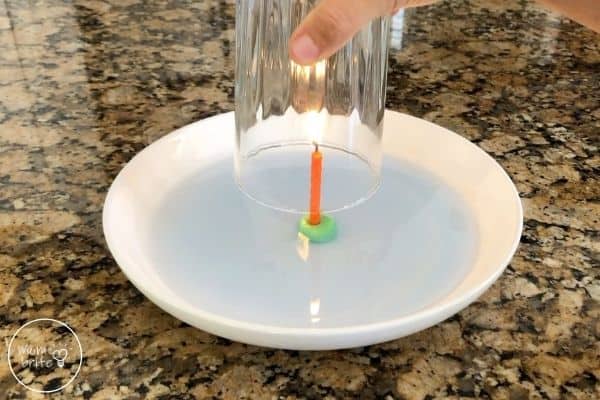
Final Thoughts on the Burning Candle Rising Water Experiment?
If your kid is like mine and wants to do this experiment multiple times, you might find that the candle goes out right away. If that happens, blow in the glass and wave it in the air and then try again.
What happens is the air in the jar is still depleted. You need to replace the oxygen in the glass before placing it over the candle.
I hope your kid is as amazed by the burning candle rising water science experiment as mine!
YOU MAY LIKE:
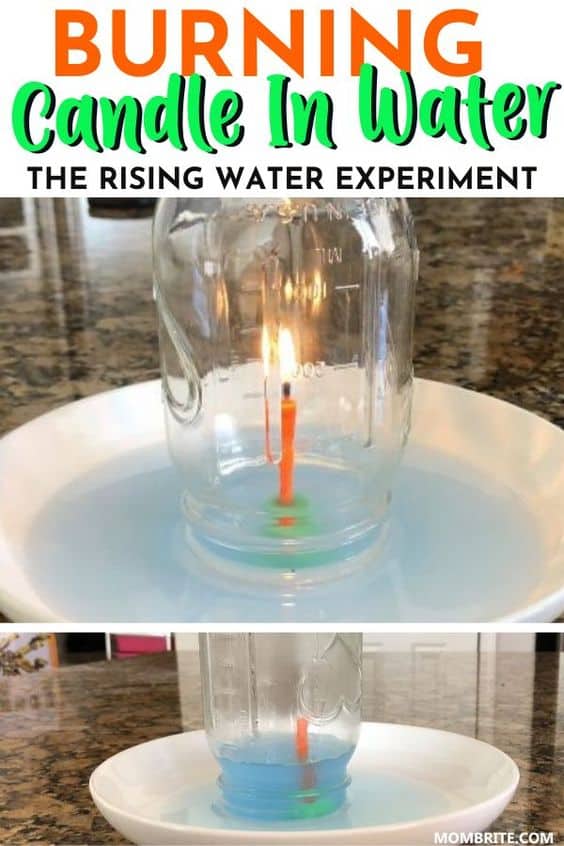

Very cool experiment! My grandkids loved it. But how can you get the water to go back down? We’ve tried using a blow dryer on the glass, to heat up the air inside.
We have not tried getting the water back down besides breaking the vacuum by picking up the jar. You are right to try and make the air inside hot again, but I am guessing the blow dryer couldn’t make it hot enough. Maybe try the other way and make the outside air cool? I would love to figure this out, I will get back to you after I conduct some experiments!
Hi. I love it .very nice experiment. I want to told something I am take participate in the STEM competition. in year 2019-in subang 2020-online (covid-19)